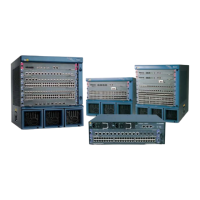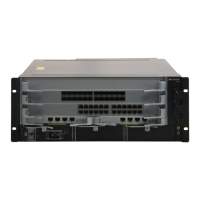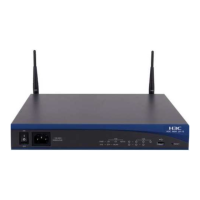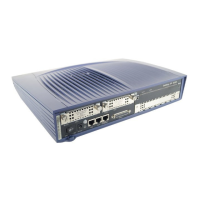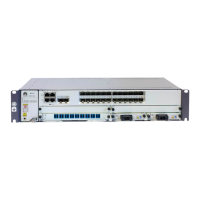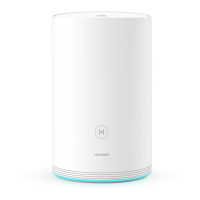l IDs and virtual IP addresses of the VRRP groups
l Priorities of Switch A and Switch B in the VRRP groups
Procedure
Step 1 Configure interworking between devices on the network.
# Configure the default gateway of Host A to the virtual IP address 10.1.1.111 of VRRP group
1, the default gateway of Host B to 20.1.1.1, and the default gateway of Host C to the virtual IP
address 10.1.1.112 of VRRP group 2.
# Configure OSPF between Switch A, Switch B, and Switch C.
For details, see OSPF Configuration.
Step 2 Configure VRRP groups.
# On Switch A, assign an IP address to VLANIF 100. Create VRRP group 1 and set the priority
of Switch A in VRRP group 1 to 120 so that Switch A functions as the master. Create VRRP
group 2 and retain the default priority (100) of Switch A in VRRP group 2 so that Switch A
functions as the backup device in VRRP group 2.
<Quidway> system-view
[Quidway] sysname SwitchA
[SwitchA] interface vlanif 100
[SwitchA-Vlanif100] ip address 10.1.1.1 24
[SwitchA-Vlanif100] vrrp vrid 1 virtual-ip 10.1.1.111
[SwitchA-Vlanif100] vrrp vrid 1 priority 120
[SwitchA-Vlanif100] vrrp vrid 2 virtual-ip 10.1.1.112
[SwitchA-Vlanif100] quit
# On Switch B, assign an IP address to VLANIF 100. Create VRRP group 1 and retain the default
priority (100) of Switch B in VRRP group 1 so that Switch B functions as the backup. # Create
VRRP group 2 on Switch B and set the priority of Switch B in VRRP group 2 to 120 so that
Switch B functions as the master in VRRP group 2.
<Quidway> system-view
[Quidway] sysname SwitchB
[SwitchB] interface vlanif 100
[SwitchB-Vlanif100] ip address 10.1.1.2 24
[SwitchB-Vlanif100] vrrp vrid 1 virtual-ip 10.1.1.111
[SwitchB-Vlanif100] vrrp vrid 2 virtual-ip 10.1.1.112
[SwitchB-Vlanif100] vrrp vrid 2 priority 120
[SwitchB-Vlanif100] quit
Step 3 Verify the configuration.
After the preceding configuration, Host A and Host C can ping Host B successfully.
Tracert Host B from Host A and Host C. Packets from Host A to Host B pass through Switch
A and Switch C. Packets from Host C to Host B pass through Switch B and Switch C. That is,
load balancing is implemented between Switch A and Switch B.
<HostA> tracert 20.1.1.100
traceroute to 20.1.1.100(20.1.1.100) 30 hops max,40 bytes packet
1 10.1.1.1 120 ms 50 ms 60 ms
2 192.168.1.2 100 ms 60 ms 60 ms
3 20.1.1.100 130 ms 90 ms 90 ms
<HostC> tracert 20.1.1.100
traceroute to 20.1.1.100(20.1.1.100) 30 hops max,40 bytes packet
1 10.1.1.2 30 ms 60 ms 40 ms
2 192.168.2.2 90 ms 60 ms 60 ms
3 20.1.1.100 70 ms 60 ms 90 ms
Quidway S6700 Series Ethernet Switches
Configuration Guide - Reliability 6 VRRP and VRRP6 Configuration
Issue 01 (2011-07-15) Huawei Proprietary and Confidential
Copyright © Huawei Technologies Co., Ltd.
256

